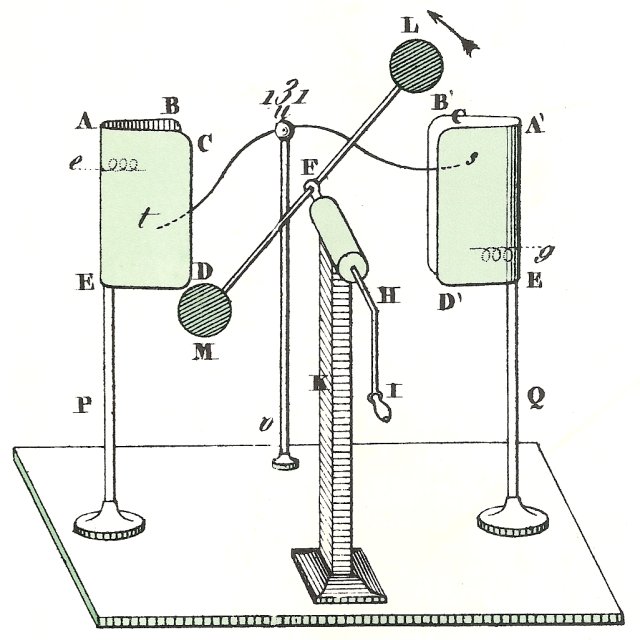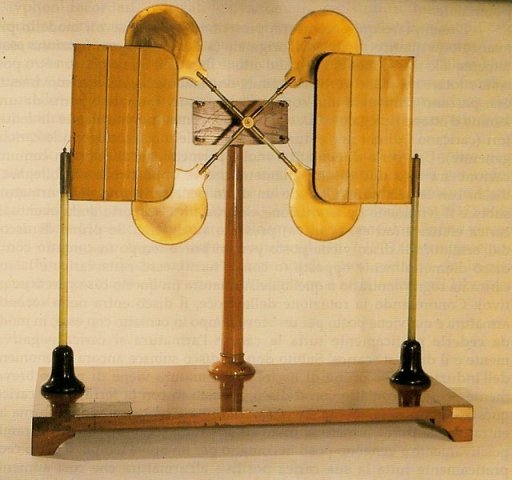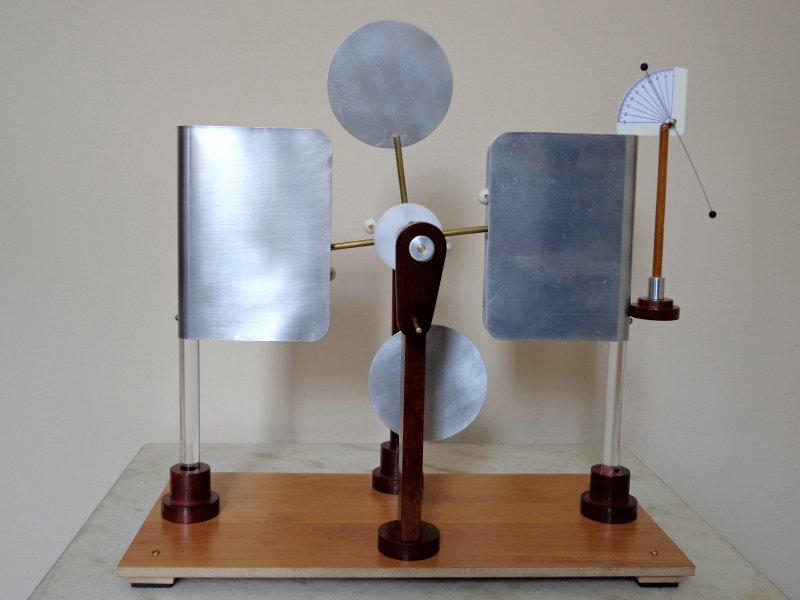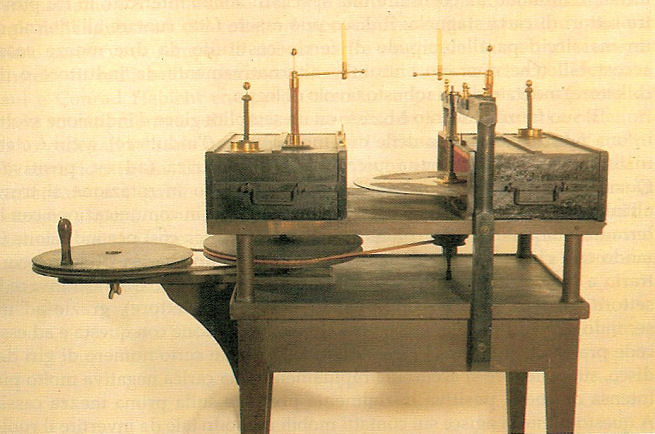

Belli's "duplicatore" was
the first
symmetrical "doubler" with rotating motion. It was described by the
Italian scientist Giuseppe Belli in the third volume of his Treatise on
Experimental Physics, published in 1838 [1][60], described as a
prototype.for a more powerful machine, that Belli had already described
in a paper in 1831 [2][p61]. The paper mentions development of these
machines for four years, and so, supposing that the paper was prepared
by 1830, machines like the "duplicatore" were in development by 1826
(this date is mentioned in some texts [3], but without references).
The machine didn't attract much attention initially, but when Lord
Kelvin described his "Replenisher" in 1868 [p92], the structure was
recognized as essentially the same of Belli's device [4].
Its consists of two, or more, metal disks L-M mounted on insulating rods and can rotate around the central axle F-H turned by the crank I. While rotating they pass inside the charge collectors A-A', that are metal plates folded in "U" mounted on insulating pillars P-Q. Inside the collectors, the disks touch springs connected to the collectors, and a neutralizer bar s-t fixed in the support u, that is not made of insulating material and so can be considered as grounded. If some charge is present at one of the collectors, when a disk touches the neutralizer inside this collector it receives opposite charge from the neutralizer. Continuing the rotation, the carrier touches the spring of the other collector, and transfers to it most of its charge by a Faraday "ice-pail" effect, where the charge moves to the external conductor due to the repulsion between equal charges. The disk then touches again the neutralizer, inside the other collector, receiving again opposite charge to the charge just transferred and the charge already present on the collector. This charge is then transferred to the first collector, reinforcing the charge there, and the cycle repeats. If body capacitances are ignored, the disks copy the charge on the collectors when touching the neutralizer, and double the charges on both collectors when touching their springs, twice per turn. In practice the doubling is incomplete, because the collectors have significant body capacitance, the shielding made by the collectors is not perfect, and the disks don't receive a complete inverted copy of the charge on the collectors when touching the neutralizer.
This machine was not the first device producing symmetrical charges. Wilson's machine (1804) could be operated in a similar way, with back-and-forth motion, and Volta, Lichtenberg, and others, had already described how to generate symmetrical charges with the "Electrophorus" much before.
Examples of the original machine are difficult to find. The pictures below show a model with gears for speed multiplication, that is now at Liceo Parini, Milan, that seems to be from Belli's time, and an elaborate machine with four carriers, that is at the Museum of the University of Pavia [5],


Drawings
of the machine can be found in several publications, but with few variations. The drawing at the
top of the page is from [3], and is a copy with some color added from
the picture in Belli's book [1]. This picture is from [4],
showing the charge collectors having a "V" shape. The most common picture [p14][4], shows
the neutralizer apparently passing behind the right collector, what is
incorrect, as it must touch the carriers inside the collectors. This
section of the plate in Belli's book [1][5] shows three views of the machine, a detail of a collector spring contact, and other unrelated devices.
Reproduction of Belli's doubler
In November 2012 I built a version of Belli's doubler, shown in the pictures below. I made the collectors and four carriers with 0.5 mm aluminum plate, used acrylic rods in the support of the collectors, and made a central hub of HDPE and acrylic to support the carriers, mounted at the tips of brass rods. I mounted the neutralizer bar on a separate wood support, as in the original machine, but made its brushes touch the rods holding the carriers close to the central hub. The brushes for connections with the collectors I mounted at the edges of the collectors, also touching the supporting rods of the carriers. All the brushes can then be adjusted at their best positions. The brushes were made with nickel-chrome wire wrapped on embroidering lines. In this way they don't break too easily, but may cause some startup difficulty. The collectors measure 15 x 11 cm, separated by 11 cm, and form "Us" with 2.5 cm of aperture. The carriers are 9 cm disks. The crank moving the carriers was mounted on a single support similar to the one in the original machine. 

![]()
The machine works as expected, quickly charging the collectors to about 12 kV, positive and negative, before corona leakage at the edges of the carriers and collectors limits the charging. Little sparks can be seen and heard at the brushes. A first version of the machine was built with the holes holding the carriers at the hub crossing it completely. This caused sparks at the center hole of the hub. A new hub was made with holes not crossing it completely, what solved the problem. The rods are fixed to the hub by pressure only, and the hub is also fixed over the central acrylic cylinder by pressure. An unexpected effect is that the machine works with one collector grounded, producing greater voltage at the other (~18 kV). The neutralizer then develops a voltage of about half this value. Apparently the MDF board used for base provides enough insulation to keep the neutralizer effectively floating. A consequence of this is that if current is drawn from one collector its voltage quickly drops, while the voltage at the other rises. Significant current can be drawn from just one collector only if the other collector is grounded, or if the neutralizer is grounded. This happens in all electrostatic machines with floating neutralizers. This machine, that turns slowly because there is no pulley system, produces very little current (less than 1 µA). The maximum current can be measured by the time that it takes to charge a Leyden jar of known capacitance to a known voltage, connected to one collector, with the neutralizer grounded and the other collector insulated, with the machine at the maximum voltage.
A similar machine was described by Elster and Geitel in 1885 [6] as a didactic machine, apparently without knowledge of the previous works.
A video of the machine in operation.
Belli's disk machine
The machine described in Belli's 1831
paper [2], the "macchina ad attuazione", shown below is very different,
and was not intended for
symmetrical operation. It has a glass disk with three insulated metal
foil
sectors, that can be turned at high speed by a double pulley mechanism.
The disk turns inside two open boxes, that work as two Leyden jars,
with the external iron box being the outer plate, another inner iron
box
being the inner plate, and resin insulation separating the inner and
outer boxes. The edges of the inner boxes are at some distance inside
the outer
boxes, so when the two parts are joined the outer conductors are in
contact but the inner conductors are insulated. Each box has a contact
post in connection with the inner conductor and a single contact with
the disk surface, terminating on a light metal brush,
both passing through glass tubes. The lower sides of the inner
boxes are covered by glass plates, for better insulation. To operate
the
machine, the boxes are joined, some charge is put on the inner
conductor of
one of the boxes (Belli suggests just touching the internal connector
with a silver coin), the disk connection of this box is grounded, and
the
disk connection of the other box is connected to the corresponding
internal conductor connection. The rotation of the disk then charges
the sectors by induction, as in the Electrophorus,
and transports
a current that charges the other box with
charge opposite to the
charge initially put in the first box, to an amount that is directly
proportional to the number of turns. After some turns the connections
can be reversed, with the second box being used as inductor and the
first as collector, reinforcing the charge on it. When both boxes are
well charged, after a few reversals of the connections, a torrent of
sparks can be obtained between the two disk
contacts, or the machine can be used as a charge source for other
objectives, as any electrostatic generator, while the boxes remain
charged. Note that the fundamental difference between this machine and
the symmetrical doubler is the presence of just two contacts with the
rotating disk, that can be used as charge collectors or neutralizers,
but not at the same time. The use of the double boxes, forming
capacitors and Faraday cages around the disk, is also unusual. At the
end of [2] a comment is made about using just two sectors and the
addition of a bar that could put them in contact, in fact making
it operate as the "duplicatore". The
machine in the picture below [5] is in
the Museum of the University of Pavia. The drawing is from [2][5].


Thanks to Bryan Warner and Paolo Brenni for discussions and materials about these machines.
Created: 18 December 2012
Last update: 1 January 2013
Developed and maintained by Antonio
Carlos
M. de Queiroz.
Return to Electrostatic Machines